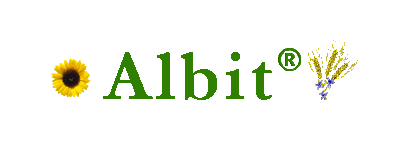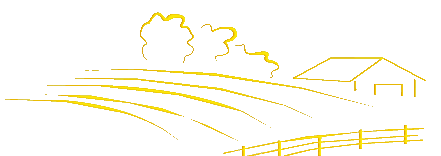|
|
Materials used in this chapter were published in the book “Biostimulant Albit for increasing the yield and protection of agricultural crops”, Ed. Prof. Ŕ. Melkumova, All-Russia Institute of Plant Protection, Russia, 2006. Albit may be applied in a mixture with other biological products and plant growth regulators. In all field trials conducted to date, the treatment of plants with such mixtures showed a significant positive effect. However, these combinations depending on product, may demonstrate both a synergistic effect (mutual enhancement) and a mutual decrease of activity. Biological products and plant growth regulators may be divided into 2 groups based on the effectiveness of combination with Albit. The first group includes products that enhances
effect of Albit. First of all, it is humates. Humates are polygenic group,
their composition and properties depend on method of production. Therefore,
Albit is differently combined with various humates. The effectiveness of the
combination with Albit increases in the range: In our country, lignohumate is registered as an agrochemical product. For more detailed information about combined application of Albit with lignohumate, please see “Combination with fertilizers”. The maximal absolute yield increase of grain crops was obtained in combined application of Albit (1.5 t/ha) with humates (“Plemzavod named after V.I. Chapaev”, Krasnodar Territory, 2003). According to trials of Krasnodar Territory, combined application of Albit with humates gave a stable increase of gluten content in winter wheat (5.3%). Separate application of these products did not give the such positive effect. According to data of “Ecology LLC” (farms of Tselinsky district, Rostov region, 2001-2003), pre-sowing seed treatment of winter wheat was optimal in the following composition: Albit 40 g/t + product based on thiabendazole + flutriafol 1 L/t + potassium humate 200 g/t + adjuvants. This composition allows to significantly improve overwintering of plants, completely get rid of root rots, rapidly increase the drought resistance of plants in spring and summer, increase weight of plant roots in 2-4 times.According to trials conducted on winter wheat var. Pobeda-50 at the National Center for Grain named after P.P. Lukyanenko (2004), adding of Albit to all tested varieties of humates during vegetative treatment (potassium humate, potassium and sodium lignohumates, hydrohumate, peat oxidate) provided yield increase 0.09–0.25 t/ha (3 t/ha was in the control) in comparison with application of pure humates. On sunflower, the maximal effect of Albit is observed either in variant with seed treatment or in variant with spraying at the beginning of the growing season. On the other hand, according to trials of Shakhtinsky district of Rostov region (2005), humates showed visible growth-stimulating effect in the second half of the growing season. Therefore, for achievement the maximal effect on the plant culture, the following combination of products seems to be optimal: presowing seed treatment with Albit (possibly in combination with spraying at the stage of 4-7 true leaves) + treatment with humates in the second half of the growing season. There are few biological products enhancing the effect of Albit, since Albit itself is a complex product that combines many components and have a lot of useful functions. Therefore, it is unlikely that adding of extra components to Albit may enhance its effect. Effectiveness of combined application of Albit was shown not only with humates, but also with Immunocytophyte, Chitosan and Krezacin. All these products have a specific target of action. Albit as a plant growth regulator has a wide rang of action: firstly, Albit “insures” these products in case of “failure to hit the target”; secondly, Albit enhances their effect due to the action to other targets. In field trials of Krasnodar Territory, the effectiveness of combined application of Albit with complex microbial product EM was also shown. The second group includes biological products whose combination with Albit is ineffective. The fact is due to Albit already contains the corresponding components and their extra addition does not lead to enhancement their action. For example, Albit is poorly compatible with Silk, Novosil, Biosil, Terpenol and other analogous products based on triterpene acids, because Albit contains this active ingredient. Thus, adding of excess amount of triterpene acids leads to decrease the effect. In the field trial of Experimental-industrial economy Plemzavod “Kuban’” (Gulkevich district of Krasnodar Territory, 2003), yield of soybean in control was 1,83 t/ha; in variant with product based on triterpenic acids – 0.31 t/ha; in variant with only Albit application – 0.49 t/ha; in combined application of Albit with the same product – 0.25 t/ha. The same results were shown in trials on sunflower (“Plemzavod named after V.I. Chapaev”, Krasnodar Territory, 2003): in variant with seed treatment, adding the another product based on triterpene acids to Albit reduced the effect of Albit from 24 to 18.3%. Combination of Albit with biological products based on living microorganisms (based on genera Agrobacterium, Arthrobacter, Azospirillum, Bacillus, Beauveria, Burkholderia, Chaetomium, Flavobacterium, Penicillium, Pseudomonas, Serratia, Streptomyces, etc.) also give low results. Microorganisms in these products prefer to use Albit as an easy accessible substrate for growth, instead of developing with using inaccessible nutrient resources of the soil, plant exudates or pathogenic microorganisms (hyperparasitism). As a result, the effectiveness of Albit is reduced. Products based on spore-forming bacilli of Bacillus subtilis (for example, Phytosporin) are exception. Microorganisms in these products are in a spore form and cannot quickly utilize Albit. When spores of B. subtilis germinate, Albit due to the effect on the soil microbial community have time to create the most favorable conditions for development of these bacteria. For example, Albit is able to increase the abundance of spore bacteria on barley roots in 9 times to control (Table 2). When B. subtilis is additionally applied in combination with Albit, this allows to fully reveal their potential in the ideal conditions. For example, the yield of winter wheat var. Vassa in variant with product based on B. subtilis was 5.2 t/ha; in variant with product based on B. subtilis and Albit – 5.77 t/ha (yield increase 0.57 t/ha) (“Plezavod named after V.I. Chapaev”, Krasnodar Territory, 2015). The same results were obtained in Bulgaria, Novosibirsk and Tyumen regions.
|
|
||||||||||||||||||||||||||||||||
Terms and Conditions
|
|


